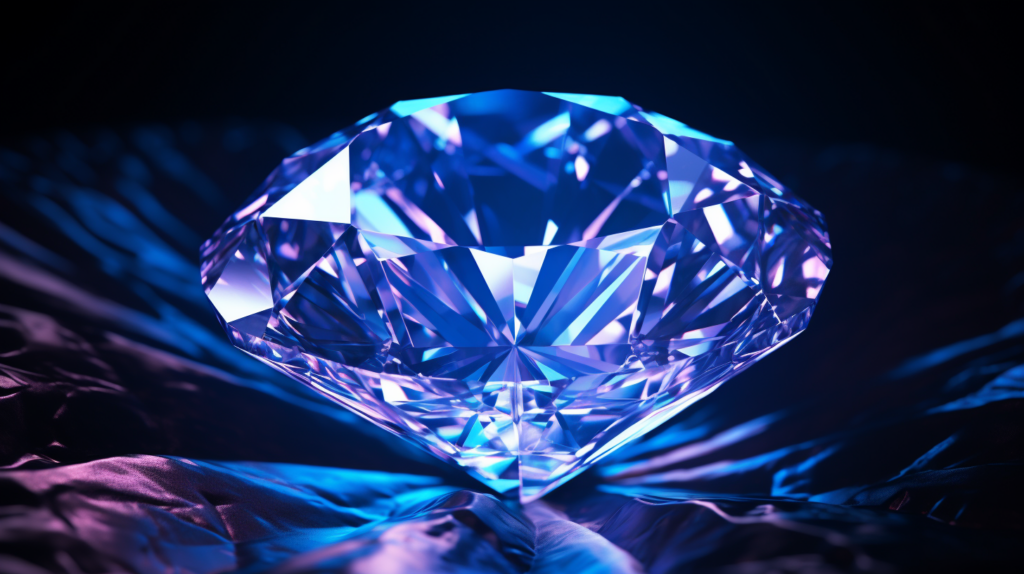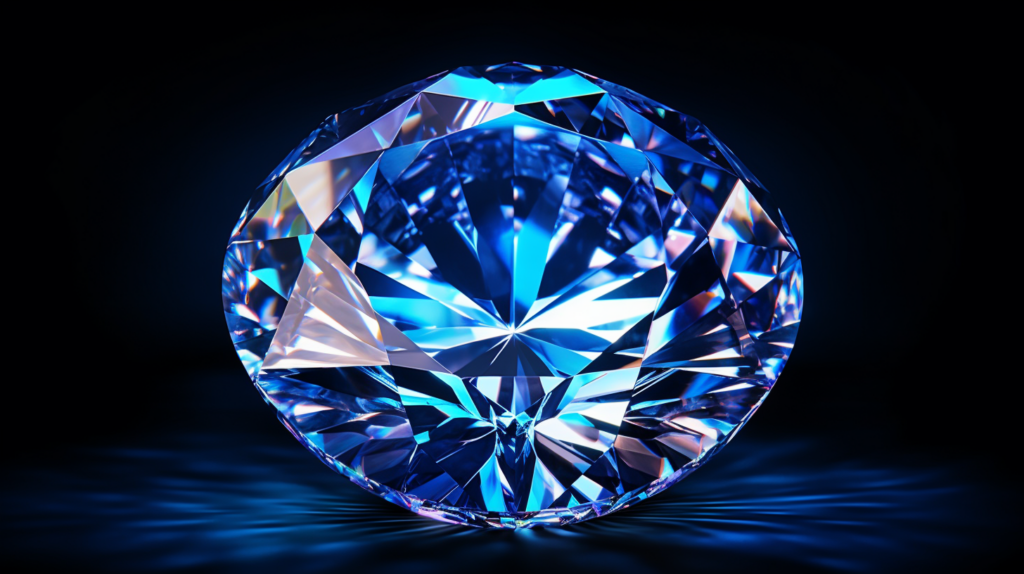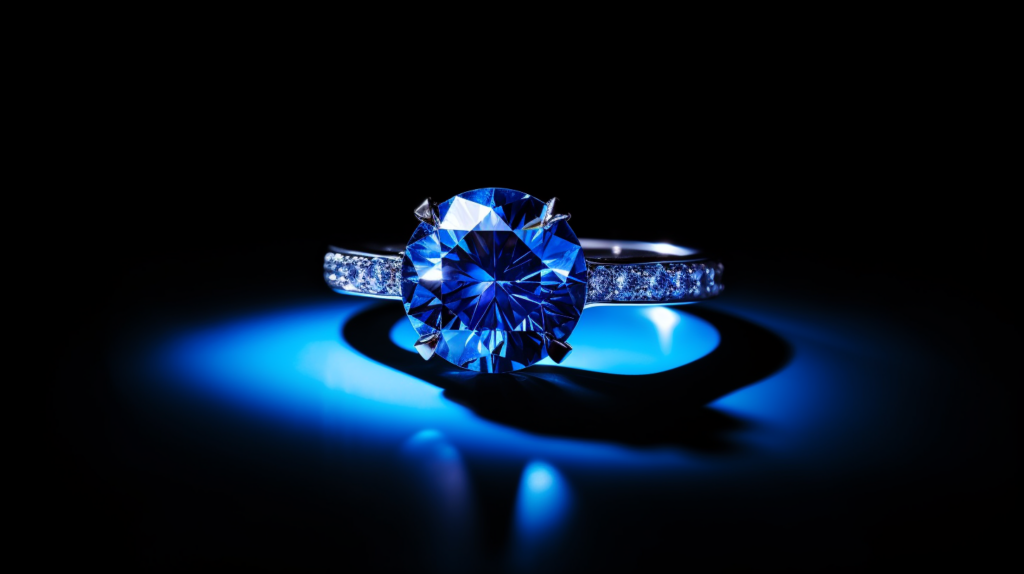Diamond Fluorescence Review: Explore the captivating world of diamond fluorescence with our comprehensive guide!
We’ll cover its grading, effects, and influencing factors. Get ready to explore the mesmerizing glow emitted by certain diamonds when exposed to UV rays.
Discover how fluorescence can enhance or detract from a diamond’s appearance with BrighterGuide. They gain valuable insights into evaluating its impact on color and transparency.
Let’s dive into the remarkable world of fluorescence of a diamond.
Key Takeaways
- Explore the world of diamond fluorescence, where UV rays reveal a mesmerizing glow in certain diamonds.
- Understand diamond fluorescence, its impact on appearance, and the subjective nature of its effects.
- Discover the captivating world of fluorescence in diamonds and its influence on their beauty.
What is diamond fluorescence?

Understanding diamond fluorescence is essential when considering the beauty and quality of these precious stones. Diamonds’ Fluorescence occurs when exposed to long-wave UV light, commonly found in natural sunlight and some artificial lighting environments. This phenomenon can cause diamonds to exhibit a fluorescent glow, typically blue but sometimes yellow or orange, depending on the presence of nitrogen atoms within the diamond. However, once the UV light source, such as ultraviolet light or black light, is removed, the fluorescence ceases, and the diamond no longer glows.
Contrary to popular belief, diamond fluorescence is not a grading factor like the traditional 4Cs (color, cuts, clarity, and carat weight). Instead, it is an identifying characteristic often described in diamond grading reports issued by reputable institutions like the Gemological Institute of America (GIA) or the American Gem Society Laboratories. The GIA Diamond Grading Reports categorize the intensity of a diamond’s fluorescence as None, Faint, Medium, Strong, or Very Strong.
Most natural diamonds, including colorless diamonds and colored diamonds such as blue diamonds and yellow diamonds, do not exhibit fluorescence. However, a significant percentage of diamonds, particularly those with a lower color grade, display some level of fluorescence, usually blue, when they fluoresce. The fluorescence level, from faint to strong fluorescence, can influence the appearance of diamonds under certain lighting conditions, particularly under ultraviolet light or in direct sunlight.
The visual impact of blue fluorescence on a diamond varies. Diamonds with faint or medium fluorescence might appear whiter or have a more desirable color appearance, enhancing their visual appeal, especially under UV light or in natural daylight. This can sometimes lead to cost savings for the diamond buyer, as a diamond with medium fluorescence might be priced lower than a similar non-fluorescent diamond. On the other hand, intense blue fluorescence, particularly in diamonds within the D to H color range, can give the diamond a hazy appearance or milky appearance, which might be less appealing to some. However, the impact of fluorescence on a diamond’s beauty is highly subjective and varies from one individual to another.
In the diamond industry, the presence of fluorescence can be a topic of debate among trade professionals. While some consider it a negative impact, reducing the value and clarity of the diamond, others view it as a unique feature that can enhance the stone’s character. For example, a strong or blue fluorescence diamond may have a unique visual difference that sets it apart from a non-fluorescent diamond.
When viewing diamonds in person, whether at diamond jewelry stores or through a diamond search online, it’s crucial to observe the diamond under various kinds of lighting, including natural light and fluorescent light, to understand the impact of fluorescence. This helps make an informed decision, particularly if you are considering special stones like white diamonds, fancy color diamonds, or lab-grown diamonds, which might have different fluorescence characteristics than natural diamonds.
Diamond Fluorescence Under a UV Light

Diamond fluorescence under UV light can reveal unique and vibrant colors in the diamond. When a diamond is exposed to an ultraviolet light source, it can emit a glowing hue that adds a touch of enchantment to its appearance. Here are four key points about diamond fluorescence under UV light.
- Visual Impact: Diamond fluorescence determines UV light color intensity. Medium-to-strong blue fluorescence diamonds appear ghostly blue. Fluorescence under UV light has little visual impact, thus, most people won’t see the diamond flashing in their daily lives.
- Impact on Diamond Color: Generally, fluorescence in diamonds has little to no impact on the diamond’s color in visible light. However, strong blue fluorescence can cause the diamond to appear hazy in regular lighting conditions.
- Evaluating Fluorescence: When considering fluorescence in a diamond. It’s important to take into account personal taste and desired appearance. Slight or faint fluorescence can actually improve a diamond’s color and make it appear more white. On the other hand, strong or very strong blue fluorescence can make the diamond appear hazy or cloudy diamond. Especially when combined with a high color grade.
- Buying Considerations: You must check fluorescence while buying a diamond. Ignoring fluorescence can lower a diamond’s price and investment value. Before buying a diamond, evaluate its fluorescence and look.
One must understand its effects to determine if fluorescence under UV light affects a diamond’s beauty and worth. Let’s examine whether fluorescence benefits or harms diamonds.
Does Fluorescence Have a Positive or Negative Impact On a Diamond?

Fluorescence can have varying effects on the beauty of a diamond. However, D-color, E-color, and F-color diamonds with any fluorescence are generally considered less desirable and less valuable. When it comes to diamond shopping. Understanding the positive and negative impacts of fluorescence is crucial.
On one hand, fluorescence can positively impact a diamond’s appearance. Slight or faint fluorescence can sometimes improve a diamond’s color. On the other hand, strong or very strong blue fluorescence can make the diamond appear hazy or cloudy. Additionally, fluorescence can save money without compromising brilliance. Diamonds with faint fluorescence are often priced lower than non-fluorescent diamonds.
However, fluorescence can also have a negative impact on a diamond. Strong or very strong blue fluorescence, especially when paired with a high color grade, can make the diamond appear hazy or cloudy. This can diminish the overall beauty and transparency of the stone. Additionally, D-color, E-color, and F-color diamonds with any fluorescence are considered less desirable and less valuable.
Perception of fluorescence is subjective and depends on personal choice. Some may find the fluorescence effect visually pleasing and distinctive, while others may dislike it. When buying fluorescence diamonds, compare them to other diamonds of the same color grade under various lighting. This will show if fluorescence improves or detracts from the diamond’s attractiveness.
Does Fluorescence Improve Diamond Color?

Fluorescence may enhance or detract from a diamond’s appearance, but a common concern is whether it improves color. Consider these four crucial factors:
- Appearance of Color: Diamonds with especially modest fluorescence may seem colorless or white. This might benefit diamond lovers who want a brighter diamond.
- Color Appearance: However, it’s important to note that strong or very strong blue fluorescence can sometimes cause a diamond to appear hazy or cloudy. This can detract from the overall color appearance of the diamond, especially in regular lighting conditions.
- Diamond Pro: Medium blue fluorescence, when paired with a high color grade, can sometimes create a milky or hazy appearance. This is particularly true for D-color, E-color, and F-color diamonds with any fluorescence. In these cases, the fluorescence may not enhance the diamond’s color as desired.
- Lab-Grown Diamonds: Fluorescence can impact the appearance of both natural and lab-grown diamonds. Therefore, it’s important to evaluate the fluorescence of lab-grown diamonds in person and consider its effect on the color appearance.
These variables make it crucial to evaluate fluorescence’s effects on diamond look and color before buying. Check out our diamond fluorescence evaluation suggestions in the following section to make an informed choice.
7 Tips on Diamond Fluorescence

After thoroughly studying its effects on the diamond look, we created some diamond fluorescence assessment suggestions.
The degree of fluorescence, diamond color, and personal preference should be considered while assessing fluorescence diamonds.
Note these important tips:
- Degree of Fluorescence: Diamond fluorescence ranges from None to Very Strong. D-F diamonds with strong fluorescence may look murky or hazy, whereas mild fluorescence might make them appear whiter.
- Color of the Diamond: Yellow fluorescence may make diamonds seem yellowish, which some purchasers may not like. However, intense blue fluorescence may give a diamond a distinctive and attractive shine under ultraviolet or black light.
- Personal Preference: The impact of fluorescence on a diamond’s beauty is subjective. Some individuals prefer diamonds with no fluorescence for a more classic look, while others appreciate fluorescent diamonds’ unique character and affordability.
Is diamond fluorescence good or bad
We think diamond fluorescence is subjective, with some like it and others not. Good or terrible diamond fluorescence depends on four factors:
- Personal Preference: Diamond fluorescence is subjective and varies by person. For a more conventional look, some prefer diamonds without fluorescence, while others like fluorescent diamonds’ distinctive character and affordability. When picking a fluorescence diamond, personal choice should prevail.
- Appearance: The impact of fluorescence on a diamond’s appearance can also be subjective. Slight or faint fluorescence can actually improve a diamond’s color, making it appear whiter. However, strong or very strong blue fluorescence can often make the diamond appear hazy or cloudy, especially in regular lighting conditions. It’s important to view and compare diamonds in person to assess the impact of fluorescence on their appearance.
- Value: Diamond pricing can be affected by fluorescence. For budget-conscious shoppers, luminous diamonds are cheaper. Fluorescence may also affect a diamond’s investment value and resale potential. Fluorescence’s long-term effects should be considered when buying diamonds online.
- Importance in the Diamond Industry: Fluorescence is an identifying characteristic of diamonds but isn’t a grading factor like the 4Cs. While some individuals may view fluorescence as a negative trait, the diamond industry recognizes its presence as a natural occurrence in a significant percentage of diamonds. It is important to understand the difference between diamonds with varying degrees of fluorescence and their potential impact on your overall diamond-buying process.
FAQs About Diamond Fluorescence
As experts in the field of diamond fluorescence, we’ve compiled a list of frequently asked questions to address common concerns and provide clarity on this topic.
Many people wonder if fluorescence is good or harmful for diamonds. Does fluorescence affect diamond appearance? This is a common diamond-purchasing query.
If a diamond is hazy, its fluorescence might impact its look. Remember that fluorescence doesn’t produce haziness. Fluorescence can worsen diamond haziness.
It’s also worth mentioning that fluorescence is only visible under specific lighting conditions, such as ultra-violet (UV) light or long-wave UV light. In regular lighting situations, the visual impact of fluorescence is minimal.
Understanding the relationship between fluorescence and diamond appearance is crucial when making a diamond purchase.
Conclusion
Understanding diamond fluorescence can be complex, and to assist, we’ve created a comprehensive FAQ section addressing key questions about this intriguing diamond characteristic.
Discover a wide range of fluorescent diamonds and learn more about their unique features at Blue Nile.
Unique Character: Fluorescence, especially blue fluorescence, imbues diamonds with a distinct appeal, setting them apart. This feature adds visual interest and makes each fluorescent diamond a unique treasure.
Affordability: Fluorescent diamonds often come with a more attractive price tag than non-fluorescent ones. This cost-effectiveness means you might afford a larger or higher-carat diamond, offering a budget-friendly path to owning a stunning and more prominent diamond.
Enhanced Diamond Appearance: Strong fluorescence can enhance the beauty of diamonds in the D to F color range, making these already impressive white diamonds appear even whiter and more radiant.
Shape and Shine: The influence of fluorescence extends to various diamond shapes, with round brilliant and princess cuts often showcasing it more vividly. This additional glow can amplify the natural sparkle and fire of these shapes.
Considering these advantages, fluorescent diamonds present an opportunity to own an affordable, unique, and dazzling white diamond with a captivating aura.
Sources
BrighterGuide is dedicated to providing accurate and relevant information as you explore the wonderful world of diamonds and jewelry. To this end, our writers refer to primary information sources in building each article that appears on this website. These include, but are not limited to, published news articles, government portals, research papers, and more.
- Gemological Institute of America. (n.d.). Gemological Institute Of America | All About Gemstones – GIA. https://www.gia.edu/
- Natural Diamond Grading Reports & Services. (n.d.). https://www.gia.edu/gem-lab-service/diamond-grading
- Learn How to Buy a Diamond with the GIA Diamond Buying Guide | 4Cs of Diamond Quality by GIA. (2022, July 22). GIA 4Cs. https://4cs.gia.edu/en-us/diamond-buying-guide/